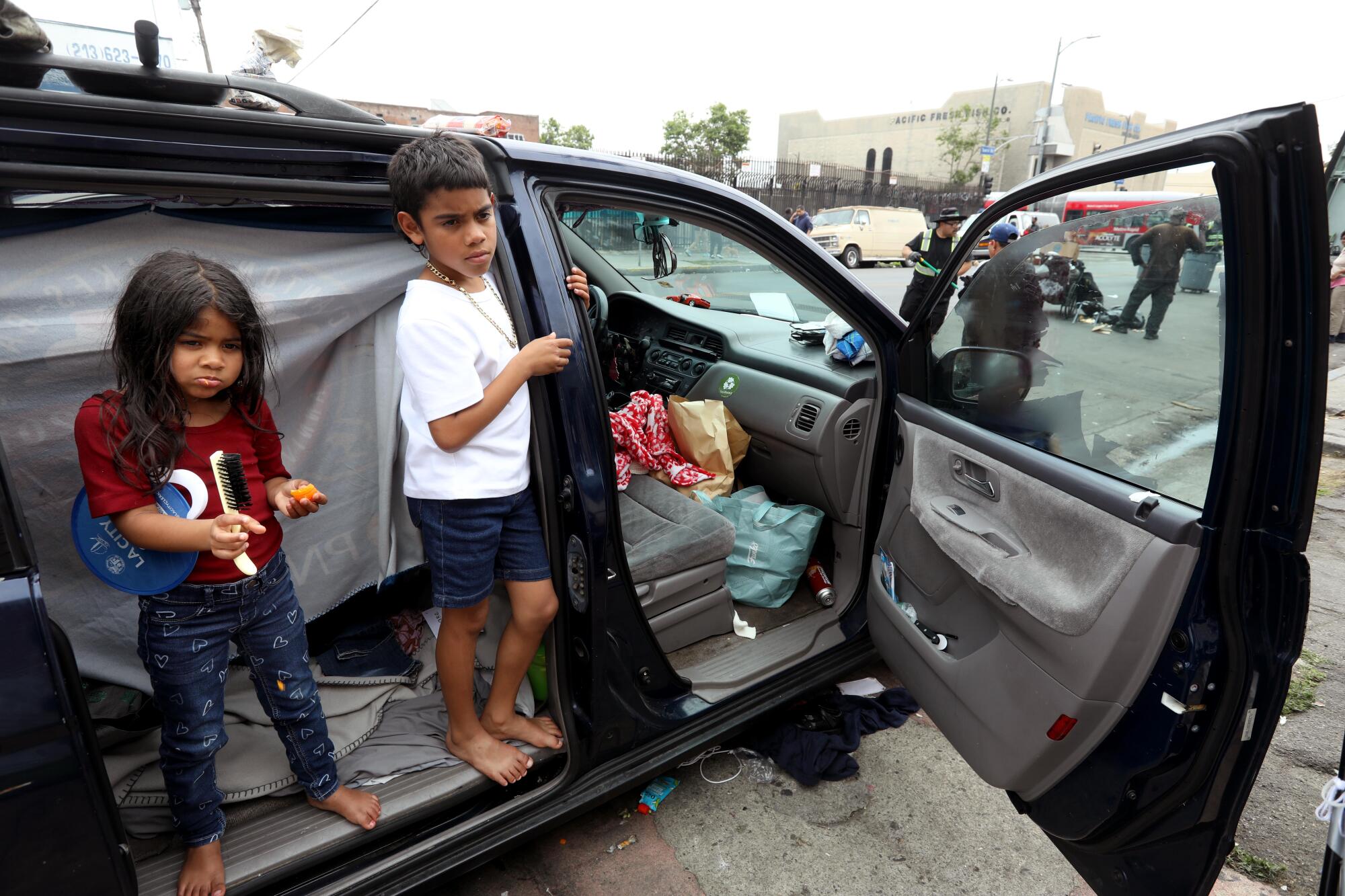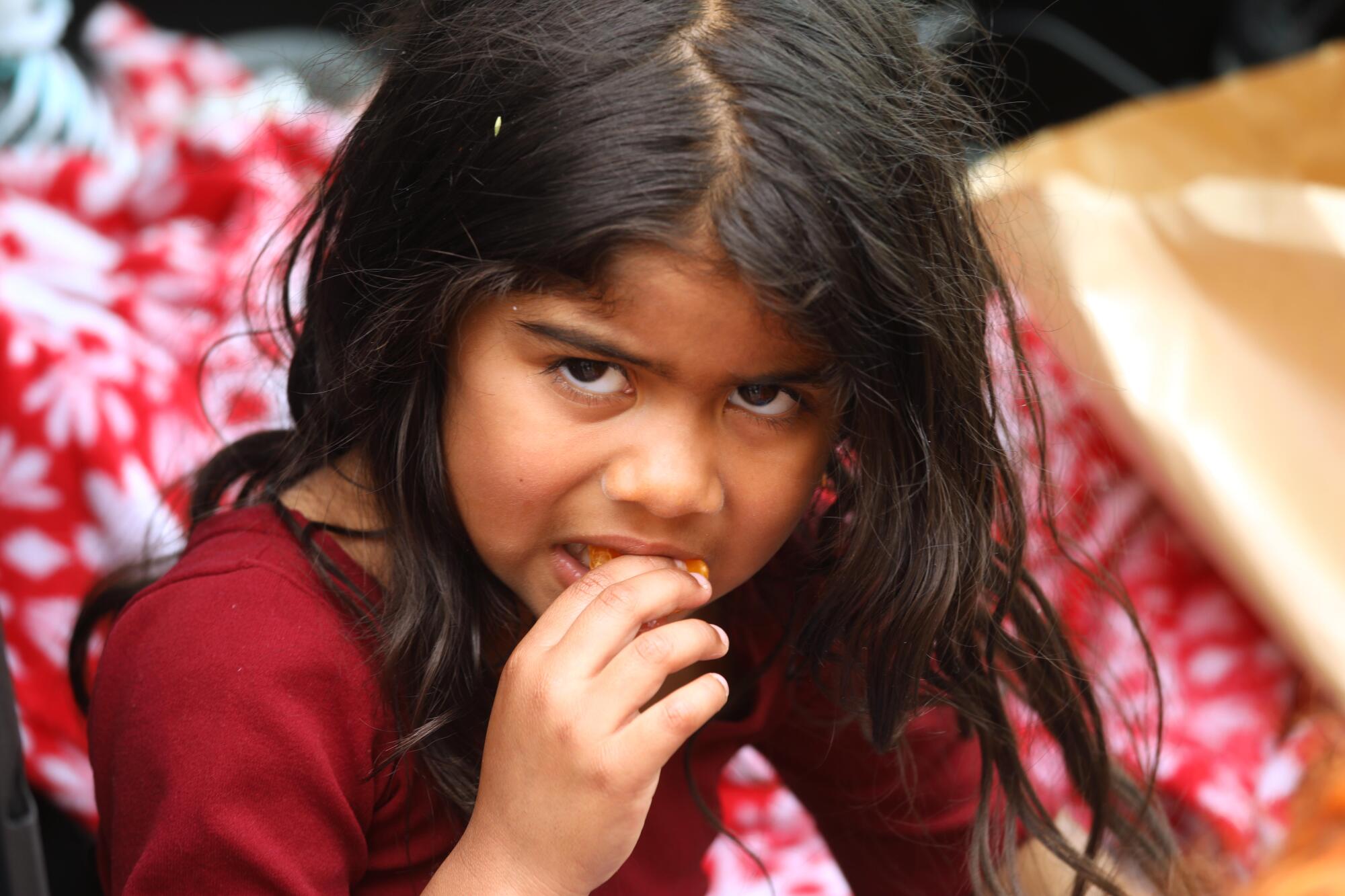
In the mornings, just past 7:30, dozens of children on Skid Row start making their way to school in the June gray.
For younger ones, the trip is somewhat easier.
A yellow bus pulls up not far from Union Rescue Mission and picks up kids who attend Ninth Street Elementary, a Los Angeles Unified School District school.

The middle schoolers study on the same campus. But theirs is a charter school and they don’t have a bus. To get to school they walk several blocks, past tents and tarp shelters, careful not to step on discarded needles or human waste.
Skid Row, if it must be said, is not a place for children. And yet there are more than 100 families living there now, with more than 200 children. The large majority stay at the mission — a privately funded shelter that is the only one in the neighborhood that accepts families.
A smaller number live in tents, often on Towne Avenue, which has become the place of last resort for families that have run out of options.
Just over a month after several migrant families living with their children on the streets of Skid Row were moved into a motel, a more extensive encampment has formed with at least seven new families living in an array of large tents, pup tents and tarp shelters.
Advocates say they believe the number of children in the neighborhood isn’t going down any time soon, as families in desperate need of shelter confront a city with insufficient options. And some are asking whether there are immediate steps that city and other officials should take to improve the quality of life for children on Skid Row as long as they remain.
In a city with a school district that has 1,300 buses, could someone ensure that all children have access to bus transportation for school? Is it possible to provide parents with day care for young children so they can work? Can there be play groups for kids living in the shelter? What about transportation to parks, after-school programs or summer classes?
“How do we create a model here on Skid Row that brings those things that every healthy neighborhood has? How do we do it in a way that’s family friendly, and easy to access?” asked Sam Joo, vice president of student and community services for the nonprofit organization Para Los Niños.

Many, though not all, of the families in the neighborhood are newly arrived migrants who crossed the border and made their way to L.A., sometimes on buses paid for, they say, by various groups in San Diego, Texas and Arizona.
The Los Angeles Homeless Services Authority (LAHSA) recently established two new interim housing facilities at former winter shelter sites in South Los Angeles to help house families living on Skid Row. Those sites, which have a total of 18 units, are already at capacity, officials said. Other families have been housed in motels.
Beyond the city of L.A., the county has also seen an overall increase in the number of families in the homeless system in recent months. There were more than 900 additional new families in the first half of this fiscal year compared with the previous one, for a total of nearly 3,500, according to county data.
In the last year, there has been a 45% increase in the number of families in L.A. County’s homeless system.
Estela Lopez, executive director of the Downtown Industrial District BID, said local businesses have been raising alarms about the number of children on Skid Row for several months. The area is an industrial one, where trucks begin arriving before dawn to the many wholesale and import/export businesses that line the streets.
Forty percent of the streetlights in the neighborhood don’t work, creating a dangerous situation for children who are bound to run and play where they live, Lopez said.

Then there are dangers that are inherent to the neighborhood.
“Skid Row is violent,” Lopez said. “There’s rampant untreated mental illness on the street. High levels of drug addiction. It’s dangerous for anyone.”
Many of the resources that exist in the neighborhood were designed to serve adults who might have substance abuse problems or mental health struggles, not newly arrived migrant families with children, she said.
“This is an entirely new population that needs an entirely new solution,” she said.
Para Los Niños, which was started after its founder read a 1979 Los Angeles Times article describing the lives of migrant children on Skid Row, has been asking local officials for funding to coordinate and increase services for children and families on Skid Row and will soon be preparing a proposal to design a model to help address some of the immediate needs confronting families.
“Whether it’s an after-school program, a parenting program, even things like potty training. If that is a barrier for a child to enter a preschool, then let’s just address that barrier,” Joo said. “Provide us the resources so we can design this model that we feel is going to be more beneficial to families.”
Parents of young children on Skid Row say they sometimes struggle to work because they don’t have a place to leave their babies and toddlers. Many early education centers do not accept children until they are potty trained — but potty training when living in a tent or a shelter with hundreds of other people can be nearly impossible.
Para Los Niños’ own Skid Row early education program, located on 6th Street, cares for children starting in infancy, offering an array of services including family support, mental health assistance and help preparing children for school. But it has a waitlist more than 100 children long.
At Charter Middle School, which is also run by Para Los Niños and serves children who live on Skid Row, about 20% of students are homeless, said Principal Chris Coyle. And more arrive every week.
1

2

3

4

5

1. Jaidelin Chacon, right, sits next to her daughter Celeste, 5, who reclines in the family car which they use for shelter while living homeless on Towne Avenue in Skid Row in Los Angeles on May 18, 2024. 2. A migrant children play in front of their family’s tent along Towne Avenue in Skid Row in downtown Los Angeles on May 11, 2024. There are hundreds of families living in Skid Row. (Genaro Molina/Los Angeles Times) 3. Migrant children Celeste, 5, left, and her brother Dylan, 8, from Columbia, let their feet hit the air while reclining in the family car where they sleep with their parents. 4. A migrant child plays with his toys in front of his family’s tent along Towne Avenue in Skid Row in downtown Los Angeles on May 11, 2024. 5. Migrant children Celeste, 5, right, and her brother Dylan, 8, from Columbia, walk by homeless encampments along Towne Avenue, where they have been living homeless, in Skid Row in downtown Los Angeles on May 18, 2024 (Genaro Molina/Los Angeles Times)
The school hasn’t been able to offer bus transportation to kids coming from Skid Row because it does not have the budget for it, so students walk the several blocks through the neighborhood to arrive at school. They stick together or walk with parents to stay safe.
“They walk in a pack,” said Zianne Rangel, the school’s family specialist. “It’s rare to see one of them walk alone.”
In response to questions from The Times about the bus that transports LAUSD students but not charter students who study on the same campus, district officials said they were “amenable to discussing options for transportation services” with the middle school.

“The foundation for any student’s academic success is built upon regular attendance, and Los Angeles Unified remains committed to ensuring all students have the resources they need to attend school consistently,” district spokeswoman Shannon Haber said in a statement.
The elementary and middle school already share a Wellness Center, where kids who are struggling emotionally can get help. Inside the center are cabinets filled with diapers, wipes, clothing and shoes that are regularly distributed to families.
When new children enroll at the middle school, their parents are given a packet with lists of food pantries, shelters, hygiene centers and safe parking spots.
But, Coyle said, there is a need to rethink what’s available to families.

He’d like to see local or state government create programs designed specifically to help newly arrived migrant families who find themselves homeless in Los Angeles, rather than trying to squeeze those families into the same system designed largely for the needs of homeless adults.
“It’s being combined as one,” he said. “But the way you treat those two different realities is much different.”
Arriving from Texas, the four migrant families from Central and South America, with children as young as 2, spent 90 days in the Union Rescue Mission in Skid Row. Then, told they’d have to pay rent they didn’t have, they formed an impromptu community in a tent encampment two blocks away.
In a statement, L.A. County Supervisor Hilda Solis, whose district includes Skid Row, said the county is working with the mayor’s office to apply for federal FEMA funds to help support migrant families. She said she has been engaging various county departments and community groups “to explore every avenue to deliver additional relief to alleviate the suffering of those in need.”
“I am committed to helping all who find themselves on Skid Row connect to shelter and services that ensure their safety and dignity,” she said.
When asked what they most need, families in the neighborhood almost uniformly respond with two things: a work permit, access to which is governed by the federal government, and an affordable place to live.
Median rent for a one-bedroom apartment in Los Angeles, where many migrants find their first jobs working as day laborers or selling fruit on street corners, is $1,872, according to real estate firm Apartment List.
Dewey Terry, who has worked to provide assistance to people on Skid Row for years, said he has been doing his best to keep an eye out for the children living on the sidewalks since they began arriving several months ago on Towne Avenue.
He helped direct them to a stretch of sidewalk across from the Skid Row Community Refresh Spot, which offers bathrooms and showers, feeling children would be safer there than on other blocks.
“I stand out here,” Terry said, pointing down the sidewalk on a recent weekday, “and I can see all the way down. I can see them playing.”
He reaches out to donors that he knows, asking for milk, food, blankets, children’s shoes and clothing. And he spray washes the gutters with disinfectant to combat illness.

“I never want the kids to have that imprint that no one cares for them,” he said.
But, he adds, children shouldn’t be there at all.
More to Read
Start your day right
Sign up for Essential California for news, features and recommendations from the L.A. Times and beyond in your inbox six days a week.
You may occasionally receive promotional content from the Los Angeles Times.










